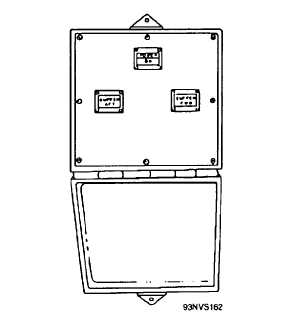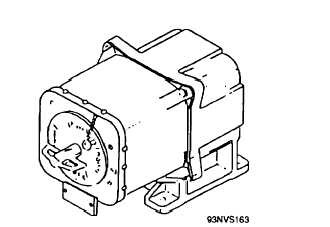two-way flow control valves, two four-way solenoid
control valves, a reducing valve, a piston-type
accumulator, a terminal box to house electrical
connections, and associated piping.
The valve
manifold assembly controls fluid flow supplied from
the hydraulic system to the buffer cylinder assembly.
NOSE-GEAR-LAUNCH BUFFER
ACCUMULATOR
The NGL buffer accumulator is located below
deck in line with and aft of the buffer cylinder. The
buffer accumulator assembly consists of a hydraulic
accumulator mounted in a support, and a tee fitting.
The buffer accumulator supplies fluid to fill
the void created as the buffer-cylinder piston rods
move forward.
The fluid is returned to the
accumulator as the piston rods retract into the
buffer cylinder.
NOSE-GEAR-LAUNCH CONTROL
SYSTEM
The operation of the NGL equipment is
automatic under normal operating conditions. The
only controls provided are the BUFFER FWD and
the BUFFER AFT push buttons found on the
deckedge and emergency control panels (fig. 5-16)
on non-ICCS vessels. On ICCS vessels they are
found on the monitor control console, the central
charging panel, or the emergency deckedge control
panel. Panel selection is made by rotating a transfer
Figure 5-16.—Deckedge and emergency control panel.
switch (fig. 5-1 7) from its normal position to its
emergency position.
Buffer Forward
The buffer forward push button is used during
air aircraft launch abort operation to move the
buffer hook forward of the holdback bar so that the
release element and holdback bar can be removed
from the aircraft.
When the BUFFER FWD push button is
pressed, the buffer forward solenoid (A) is
energized (fig. 5-15), shifting the buffer forward
solenoid valve, allowing medium-pressure
hydraulic fluid to shift the piston of the flow
control valve. When the piston of the flow
control valve shifts, fluid flow from the aft end of
the buffer cylinder assembly to the gravity tank is
shut off. This causes a pressure buildup on the aft
end of the buffer cylinder assembly pistons. Since
the area on the aft side of the pistons is larger than
the area on the forward side, the pistons, piston
rods, and attached slide assembly are driven
forward.
Buffer Aft
The buffer aft push button is pressed during an
abort operation when the aircraft holdback bar is
connected to the buffer hook, the fluid pressure
acting on the forward side of the buffer pistons will
tow the aircraft aft. When the buffer has moved
back 4 to 10 inches, the abort force is reduced
because hydraulic pressure is bled off through
exposed holes in the buffer-cylinder-assembly orifice
tubes. Aircraft braking is required prior to releasing
the push button to hold the aircraft against its thrust
Figure 5-17.—Transfer switch.
5-16



